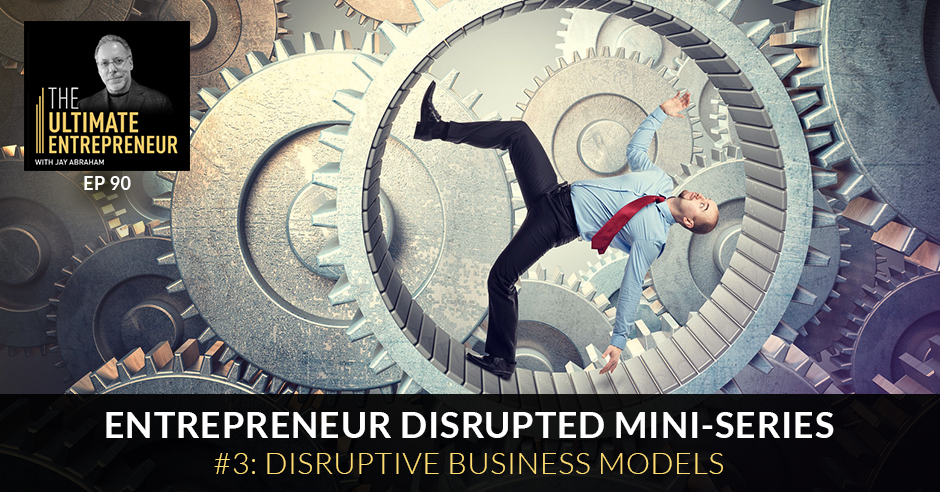
Disruptive business models are selling like hotcakes. Oftentimes, especially in these days, new entrepreneurs who are excited to start a business tend to neglect their business model without giving it the proper attention it deserves. They don’t create a foundation that allows for success to be both easier and more attainable, more sustainable. Dave Asprey and Jay Abraham go back and forth as they expertly examine real-life case studies of existing business models. The difference between giving away free content, products or services versus charging your clients for them, knowing when it’s time to pivot and change your business model. This intriguing topic will be covered in the course of two episodes: the beginning of almost a dozen more segments in the Entrepreneur Disrupted mini-series. Learn from Dave and Jay’s respective insights which they collaborated, and integrated just for your mind’s pleasure!
Listen to the podcast here:
Entrepreneur Disrupted Mini-Series – #3: Disruptive Business Models
The topic of this show is business models, more specifically disruptive business models. Oftentimes, especially in these days, new entrepreneurs who are excited to start a business rushing into it head first usually tend to neglect their business model without giving it the proper attention it deserves. They don’t create a foundation that allows for success to be both easier and more probable to attain and sustain. Hopefully, after these next two episodes that should no longer be your case. Dave and I go back and forth as we examine real life case studies of existing business models. The difference between giving away free content, products or services versus charging your clients for them, knowing when it’s time to pivot and change your business model. You’re going to love this one and this is only the beginning. This topic will be covered in the course of two episodes. This is only the beginning because there are almost a dozen more segments in this special edition series. I hope you enjoy it because I enjoyed doing them with Dave because I learned. We collaborated, we integrated, we created some hybrid distinctions and you are the beneficiary. Take a lot of notes. Thank you.
We’re going to be talking about business models. This is important for you because if you’re an experienced entrepreneur, you probably know what a business model is but you probably haven’t thought that much about how they’re melting. If you’re new as an entrepreneur, you may not have thought about this. It sounds like this shouldn’t be something to say. The number of companies without coherent business models is probably an all-time high because there are lots of people with no experience starting companies. I used to define a business model as how you’re going to make money. That’s a pretty broad definition but it’s the most important one. You can zoom in with incredible levels of detail as to how you’re going to arbitrage this, how you’re going to do that, but some of the most respected companies out there aren’t making a nickel, but their model says they will at some point. The biggest one so far would be Uber. Uber’s losing money hand over fist. I interacted a good amount with Travis, the CEO of Uber, because he was at Red Swoosh and I was at one of the other big players in the content distribution industry. I ran into him very frequently but I haven’t talked to him in a long time. They have a model that says, “We’re going to pay people X amount of money to drive cars and we’re going to collect more money.” Right now, the model is, “Take money from investors and then lose it in order to buy market share with the assumption that when they have monopoly power, that this is going to be an incredibly powerful business.”
That model has been repeated lots and lots of times. In fact, at the dotcom boom there were tons of companies saying, “We’re not sure how we’re going to make money but we know having eyeballs gives us power.” Business models like that make me nervous because it’s assuming you know the future and bad things can happen. For instance, I talk a lot about the Bulletproof side. I made $6 million when I was 26. I lost it when I was 28. The lack of business model is one of the reasons that happened. I was there at Exodus Communications where pretty much the who’s who of dotcoms were all paying us huge amounts of money every month to use our buildings and our networks and all that. When they all realized that they didn’t have business models and they ran out of money because of the dotcom crash around 2001, that affected us. If those companies had coherent business models, they would have slowed down a little bit and the business model that says, “We’re going to just pour money into it because we know it will make money later,” it may be a very valid good business model. It also may be Dutch Tulip mania and it’s very hard for us to know when we’re in a bubble versus not in a bubble.

The more I see companies that say, “Our business model is to get share and traction and we don’t know how we’re going to make money,” it makes me nervous. There are billion dollar exits, mostly companies Facebook bought, that didn’t have very strong business models because Facebook has figured out how to monetize eyeballs. Google’s figured out how to monetize eyeballs. It’s not that you can’t do that, it’s just that as an average entrepreneur looking to make money, having a clear path to cashflow positive and to the actual profitability will increase your odds of success and it will increase the average value of your company.
For every one of the $500 billion dollar exits from companies that were not making money and didn’t have clear models, there are thousands of companies who had those dreams and had nothing to show for it but losing investors’ money. If you bootstrap the way I did with Bulletproof, you’re losing basically your house payments. It’s real money. I talk a lot about that $6 million but I’ve been working for a living and supporting a family of four on normal wages for a long time. Starting Bulletproof was a substantial risk. It meant quitting my job, and I did start it while I was working as a VP at a big company. My model for Bulletproof was completely backasswards. It was, “I’m going to start a blog to tell people all the stuff that I wish someone had told me when I weighed 300 pounds.” That’s my entire business model because my business model was, “I have stock options in a publicly traded company and I’m a vice president. I don’t need to make any money from this startup.” I started a blog but when I realized, “I want to make something that I can’t buy,” this gets down to the product thing. My first product was coffee beans without mold in them because I was tired of throwing away coffee that tasted good that gave me headaches and made me cranky and irritable. I created coffee beans and I wrote about the recipe and I did all these things, but that was money out of my pocket.
Eventually, my business model shifted from, “Make money from my day job,” which is relatively cushy to, “Make enough products and be confident enough that people are going to buy them, that they’ll do it.” That let me start with no funding whatsoever and drive the business to the point where I could raise $9 million in venture funding with not more than probably $40,000 of my own money invested in the company, which is not bad. The business model though, this is crazy. Sell stuff that people want; physical goods. I didn’t have Bitcoin, although Bitcoin is interesting. I didn’t sell information products which is one of those things. At the end of the day, if you’re selling anything or get money for something, information products or software are so sexy because the cost of goods is essentially zero. You can replicate them. As a contrarian who just wanted to add real value, I didn’t want to do that. If I’m going to break something, I’ll just break people who make coffee with mold in it. That’s an industry ripe for disruption because if you make it taste good, they will make it good for you. What do you think when you’re advising an entrepreneur, Jay, about business models? I like to keep it simple. How do you coach a new entrepreneur? How do you coach someone who’s at a company maybe that’s stagnated? Give me your consultant’s view on that.
I look at what they’re doing, how it’s doing, why they’re doing it. I look at what their endgame is if they know, and if they don’t, I get them to articulate. If their strategy or their business model is profoundly flawed, I’m not critical because I’ve learned that helping and enabling them to come to the realization is essential to get them to embrace alternative thinking. I have a different approach than most people. I’ve been exposed to probably 50,000 strategies, business models and I have a uniquely wired mind, not being arrogant, just clinical, where I can do like The Six Million Dollar Man and quickly access and come up with five or six or seven higher performing alternatives. Then we look together at probability and outcome. If anyone else is doing it, if it’s an alternative, how we can do it without risk or expense? Then we start building out hypothetical alternatives and evaluating them.
Do you recommend assessing your business model on a regular basis or do you do that in a state of crisis or do you see companies pivot business models frequently?
I’ll give you two answers. First of all, there’s a great quote from Socrates. “A life unexamined is a life not worth living.” There are no guarantees in life and there are less in business. If you look at any great company, most of them have pivoted at least three times, meaning their brilliant idea or their model or their approach or their articulation or their service wasn’t what they thought it would be. A business unexamined frequently and not questioned is basically a business not worth owning.
I look at the Bulletproof business model now and I have historically one of the biggest shifts. Probably the most impactful thing that I’ve done in my tech career was shifting from the assumption that we sell professional services. We have an army of consultants who will run your site for you. I sat down and I remember really well the spreadsheet grid I made and I said, “All of these things could be like pay-as-you-go services.” That was what evolved after $10 million of investment into either the first or one of the first shipping pay-as-you-go cloud services, which is the foundation for the internet as we know it today. Everything we’re doing is based on the cloud and you just pay for what you use and nothing else. That was a huge business model shift. The next two jobs I had after that was to take software licensing companies. One was called Zeus Technologies and the other one was actually Citrix and switched them from, “We sell software licenses. Pay us $100 dollars every three years to monthly pay as you go.” Screaming and kicking CFOs wanting to fire me, all of these kinds of things because it was terribly disruptive, customers wanted it. Fast forward ten years, when you buy your Microsoft Office, are you buying it for X amount per year on a subscription? Yes. Do you pay for Salesforce.com as a subscription? Yes. Is this how almost all software is consumed? Yes, because it is a better model for consumers and that’s what they want, but it breaks the financial model for these things.
Switching those things like that, those are major business small shifts. Entrepreneurs can take huge advantage of that shift because while the big guys like Citrix, I literally put my career on the line when I was there. I forced the deal on pay-as-you-go pricing for this virtual desktop thing or something. I had to basically go head to head with the VP of sales, and I’m this strategy weird guy because I thought it was really important. I have no idea if we earned money on that deal or not, but that was the future and that’s how it’s sold now. That shouldn’t have happened. In the meantime, where did the disruptors come? They came up and they built their stuff online. What disrupted the crap out of that kind of business is Google, Google Docs, Gmail, like who needs that stuff? It’s the slow moving that hurts. If you’re looking for a business model that is disruptive, this is after all Entrepreneur Disrupted, the show, you’ve got to look carefully at different payment mechanisms and also think about, should it be free? One of the things that I decided to do at Bulletproof was I took stuff that I could have easily packaged into twenty different eBooks and probably made hundreds of thousands of dollars from selling them. I said. “I’m going to give away my very best stuff for free.” I did this because I want people to read it because it’s a mission-based business, not just “I’m going to make money” business. It was most important that people read that kind of content, because it would change their behaviors, it would change their consumer patterns, and it would it would use entrepreneurship as a tool for good.
That was a major shift there and that was one of the most successful examples of a business model that you could call content-based ecommerce. It’s one of the areas where venture capitalists are investing right now, where you basically make what you could have sold as a book, what you could have sold as a magazine and you make it into content worth reading and then you use that, instead of selling advertising, to actually talk about your own products and your own company’s mission to get people educated on it, especially in doing something new and disruptive. We’re seeing other companies try and pursue that model, but in order to come up with that, I had to say I rejected the idea of selling information products. I’m with Jay who’s the master of selling information products because he sold huge numbers of conferences and digital things like that. My perspective now is I want to give as much of that away as I can. I’ve sold some courses and things like that, but I never made enough money on those to justify taking away access to those courses to other people. I’d rather that that knowledge just be out there at no cost and forego any profit I could have made from selling it and getting a fewer number of people to see it.
That’s a bit of a meandering approach towards business models, but the way to think about business models is most important. You can get any book about business models out there. It’s already obsolete because business models are changing. When I talk about Bulletproof, and I want to describe it to a potential venture capitalist investor, “We’re a media company because we have 30 million downloads on one podcast and we have three to five million people come through. We’re an e-commerce player because we have a substantial ecommerce business, and we’re in national Whole Foods and other grocers so we’re a wholesale grocery company. We have a coaching business with hundreds of people learning how to be Bulletproof coaches, so we’re a coaching and training company. They’re like, “Focus.” I’m like, “I’m an entrepreneur. Shut up. I don’t focus.” It does come down to those different divisions and there are all those different business models, but they’re all in support of a mission. You don’t have to pick just one, but you better know which ones are in and have someone who’s in charge of each of those. If you try to run businesses with that many business models, you’re going to face the F word which would be failure. Jay, drop some knowledge bombs for me about business models.

I’m going to come at it different and then you’ll stop me because I’m going to use stories and examples. I look at it different than most. My skill, my strength, my values and understanding what’s possible, not what’s being done. I will share with you four or five different examples of wild models that have worked in my life, and then explain what they were doing. Then you can stop me because I’ve got 30 I just dropped. I started with Icy Hot. The first thing you have to look at is understand the game you’re playing. The game you’re playing is lifetime value or it is strategic access. If you don’t know the game you’re playing, you can’t win at it. Our lifetime value is the following: we had looked at the buyers for this product. They were geriatric – people with arthritis, rheumatoid, all things like that that weren’t curable unless they died. We found out that every time we got someone to start buying, over 80% repurchased every year for life and of the 80%, over 40% bought additional products. Of the 40%, %20 percent bought in bulk too at a discount to give to their other friends. With that as our knowledge, and we had no money, we sold a product originally for $3. Our embedded cost of shipping it was $.55. We went to the media, we had no money. We offered them to sell the first unit and keep all the money. We took the $0.55 risk. We fulfilled right away because we were at risk on that, and we basically made money before the end of the first month. Every time we lost $5.50, we accrued $40 on average a person a year in profit for life. That was one of ours. If you remember back years ago, the book clubs and the record clubs would give you five records for a penny. Maybe they had great ways of making money on that. I don’t think so, but they had enough empirical experience that for the number of people that came, the vast majority would continue buying at full rate long term, and then go into their other clubs. This is fascinating.
Carnival Cruise which now is probably one of the biggest multi-billion dollar companies in the world, when they started, they had one boat and supposedly a good friend of mine helped them. One side of the boat they couldn’t even afford to paint, so they had to bring it in all the time on the painted side. They had very light usage. They had a boat with 800 rooms, berths, whatever you call it, cabins, and they were only selling 400. Every time they went out 400 empty, they were losing $400,000 worth of buying power. They made the decision to start using that $400,000 of buying power to trade to media for advertising that the media could use the credits to send their people. They ended up doing $100 million in the first year. They were smart enough that not only did they trade it, they charged a surcharge of $80 which covered all the cost of the cold cuts.
There was a Porsche enthusiast in Northern California who loved Porsches. He always wanted to own one. He had no money. He found a small Porsche dealer was available in Northern California but it required $1 million down payment. He didn’t have the money. He didn’t want investors. He didn’t want a loan. He found out that Porsches and any other car dealer could do demos. A demo is a car you get to drive for two months or three months, and then as long as you don’t put a minimum number of miles on it, you can sell it with a slight discount and still make a profit. He ran ads all over Northern California saying, “Drive a brand new Porsche every year for life for a one-time investment of $75,000.” He got about 300 people to pay that. They didn’t have to give up any equity. He gave up no loan. He got $3 million. He had their dealership. He had his operating.
I had a driving school in Japan, the biggest one, it’s a very marginal and competitive business. He charged $3,000, he makes about $1,000, 90% never come back. Half of the people that get their license, it’s a badge of honor, they never drive. The other half, a very small number, buy a car they just rent on the weekends for vacations. He was working his ass off trying to basically sell driving training one-time. I showed them that number one, the real opportunity was having a rental facility in his and all the other five. Once he got those working, to sub-license it to other people.
I had a Chinese motorcycle manufacturer who had virtually no money and wanted to be all over Asia. I showed him how to find a compatible manufacturer in Asia that had the same kind of distribution that had an under-utilized factory. He made a deal with the lawnmower manufacturer where all he had to do was bring the tool and die. In fact, they already had eight countries with salespeople, with distribution, 800 lawnmower dealers, and they split $10 million in the first year. I can continue but there are a lot of different models.
Finding those complex models like that usually requires detailed knowledge of customers. You need to understand where their pain points are and where they have excess capacity. Then it requires reputation or some capital. If you walk into someone with a big factory or a big warehouse and you say, “I want to do this,” they have to believe that you have the capacity and the capability to do it so they don’t waste time doing deals with people that are going to distract them which is a major issue. After you did Icy Hot and some of the other things in your career, it’s pretty easy, Jay.
You don’t have to do that. What you have to do and what I do with people is I pre-emptively prepare them to show that they have thought it through because I’ve thought it through for them, in such a way that they’ve hedged it, they understand it, they’ve already pre-validated it, and then they only want to do a test to validate it to them, a small controlled test. If you understand it, all of these can be done not by saying, “I got this vision,” but saying, “Here’s what I already did. Here’s how I validated it.” Somebody came to me for a consult. I do all these complex consults. They wanted to get control of European supplements for the United States, but they didn’t have any great position. I said, “One of the things that I’m known for is a famous quote,” because I have a lot of different methodology, concepts, stratagems, unique principles. They said, “If everyone was taken away, what would be the one you’d want?” I said, “I’d like to have the rights to everything and figure what to do with them later.”
This woman was trying to figure how she goes and sells the supplement company and how you tie it up and make sure you get protected. I said, “The first thing you do is you get a contingent commitment from a bunch of other supplement companies or complementary companies in writing that they will partner with you on this deal, and you get it tied up for you before you go and try to get the deal.” There’s a lot of ways that you can create validation and willingness for someone to try it. You don’t have to be me, although I’m much more solid about it, but there are three points. One is you’re approaching it as if you were a startup. I’m approaching it assuming you’re a regular business and you’re trying to make the normal business model better. I would argue with you not to have fisticuffs, but the first thing you want to do is see what the norm is. If you’re going to do the norm, you’re relegated to incremental growth. We’re talking about being disruptive.
It also depends on what stage of entrepreneurship you’re in. If this is your first company out of school and you didn’t go to a big business school, you’re not tied in with certain networks that might make it easier, it’s oftentimes pretty hard to approach a big partner around a B2B deal like this because you don’t have the street cred to pull it off.
I agree, but you’re making an assumption that you need to approach a single big partner. My approach is those are the hardest. You start with a lot of secondary ones. The key is who’s got more to gain than you? Your problem, changing your model, making it more profitable, pre-empting the market, can solve somebody else’s problem. If you go to the big companies that are the dominant forces, they’re going to be very difficult, both arrogant, ignorant attitudinal. The second and third tiers are going to be the ones that are going to be much more receptive and open. I always don’t do one. I do multiple ones. It’s not that hard with smaller ones. Smaller doesn’t mean small. I’m working with three $300-million companies. They’re not as big as the billion-dollar companies and they want to grow, and their model isn’t powerful enough. They’re very open because I can show them. They can test my model of taking other things or taking their model and switching it. Most people get intimidated because they want to go after the big boys, and that’s not as practical as proving it to a number of secondary ones and seeing validation. Validation, if you read Damon’s book, it’s very interesting. He talks about if you sell things in the back of your trunk and you open it up in a shopping center parking lot, you sell everything you’ve got. Even if you don’t price it right but you showed demand and you do that over and over again, people see validation. Most people don’t understand that. They want to be Olympic pole-vaulters on the first run, and the probability is low. Making deals is easy if the logic is there or shifting your model. I’ll give you an example.
Years and years ago, I had a software client in Australia. They sold enterprise software, expensive to middle-sized entrepreneurs. They were running in every one of the trade publications in Australia and they were getting about 1,000 leads a month. They were only converting about 3% because it was $50,000 or $60,000, a lot of money for a middle size. They were investing most of their money in the 997 people out of 1,000 that weren’t buying. They were getting 3% conversion making enough money, but 997 out of 1000 weren’t buying. They had to sunk cost if they were spending $100,000 a month hypothetically. They were investing $99,700 that was just going to waste. We looked at it and I said, “These guys have better things to do than get interested in esoteric. They need it and want it, they can either afford it. It’s too complicated. You don’t have good terms. Find somebody else who has an entry level one that is far more affordable and simple but can’t sell their way out of a paper bag, make a licensing arrangement to take it over, add some personalization so you make a custom version, your own white label version. Let them do whatever they’re doing because it’s not working anyhow, and offer that as a down-sell to all the 997 people who didn’t buy.” They started making so much more money from that. The frontend that used to be their whole model became nothing more than a for-profit lead generator. There are lots of ways of looking at it.
We’ve talked about finding a really good idea and having that creativity thing and systems thinking and looking how to break things. What you’re doing here is that exact same thinking with business models where the brute force, “I’m going to sell stuff,” to, “I’m going to sell different stuff to different people based on segmenting the lists and things like that.” That in this client’s case for you, it just never occurred to them. They didn’t think about it.
The reason is that most people’s world view is limited. Here’s the truth, most people have either worked for another company in the field, they’ve been tangentially involved with that industry or they’ve been drawn to it and modeled that industry. They might have read books and they might have gone to some seminars, but their spectrum, their scope of possibility, alternative options and alternative opportunities is totally limited. I have lots of stuff on this. We can put them out so people can see a lot of them. The point is when you see what’s possible, you’ve got to be a non-linear critical thinker. That’s hard for linear people. You’ve got to see connections. Tony said this about me and somebody said this about me, that I see patterns nobody else does.
It’s the pattern recognition or event correlation thing. Most entrepreneurs, like the really successful ones, are a little bit ADD. In fact, Dan Sullivan called that out. I’m in a group with him from Strategic Coach. I don’t know how expensive it is but it’s expensive to be in his top tier group but I do it. Every single person in the room looks around when he’s just getting going and these are all people running successful startups. He says, “How many of you have ADD who’s been diagnosed or something like that?” 80% of the room raises their hand and then he says, “The rest of you,” and he shows a slide with some basic behavior patterns. “How many of you does this describe?” It’s the rest of the room. “That’s great. You haven’t been diagnosed. Go see Daniel Amen, the guy who does SPECT Scans who’s been into some of my documentaries who helped me see what’s going on in my brain.” There is a brain pattern that’s good at this, but that group maybe self-selected in that there are entrepreneurs I know who are not thinkers like that. They’re bean counters like their very financial driven. Do you think that they partner with people who have a crazy brain like yours?
First of all, I did a wonderful interview with Ned Hallowell for entrepreneurs and it’s really powerful. He explains a lot of things. Number two, the stuff I do sounds way off the wall but it’s the people that appeal and love it the most are analytics because they’re all correlations, they’re all quantifications, they’re all implications. If this is to that, then this is to that. Ironically, it’s the opposite of creativity. It’s more a focus on pre-emptive access, pre-emptive or irresistible, not attraction but desirability. The people that love me are the people that are scientific. When I go to China, I’m very successful in China and it’s really one reason. Asia, Latin America, they’re very hardworking but they’re trained in rote training. It’s memorization. If I say to a Chinese entrepreneur, “What’s ten times a hundred square root, divided by one million, plus twelve add six, and then divide again by seven?” They’ll go whoom. If I say, “This is to this, and this is to this,” they won’t get it.

I had a client one time and we made him $25 million in one year just by seeing correlations. He had two companies and he operated them totally independent. One was a very high-end advisory service information for very serious world class collectible coins, not cheap ones, but very elite ones, Romans, all those things. The other was a small boutique brokerage that sold it. He was charging $300 and he had a very rigid attitude. He ran ads and if the ads didn’t bring three times their cost, he wouldn’t run them for the subscription. I said, “Have you ever looked at the correlation between subscribers and buyers?” He didn’t. It turned out that something like half bought $25,000 dollars and half of them bought $50,000 and half of them bought $100,000. The bottom line, the margins were very good but they were very ethical. “We could have bought the newsletter for everybody as long as they treated it with respect and made a fortune.” With that statement, I thought, “Let’s do it.” I went to the best newsletters out there. We made deals with them where we funded them introducing that we would buy them these newsletters for one full year, just like anybody you paid $300, and we didn’t want to do a thing except read it and analyze our recommendations. If at the end of a year, they saw they were good, renew and then use the services. We made $25 million just by looking at that correlation.
Most people don’t have the ability to take a deep breath and look at correlations, but also what I’m very good at, and I’m not saying this arrogant, is I can extrapolate. I can adapt. I can integrate. I can funnel vision, business models, derivatives, hybrids from all kinds of other industries, apply it, look at what will preempt. Preempt is the key. Part of being a disruptive entrepreneur is not just having a greater service but having a greater proposition that is irresistible. Irresistibility means, number one, easier access. Number two, taking away the difficulty of getting interested. Number three, figuring out what the whole game you’re playing is. Most people don’t know any of that.
It’s true they don’t. The way of thinking is actually important. In our next episode, I want to circle back on what we talked about here. We talked about what happens when you get a quantitative entrepreneur versus a systems thinker entrepreneur and how to build teams where you fill in for your weaknesses. That’s it for this episode of Entrepreneur Disrupted Radio. I’m Dave Asprey and you’ve been listening to Jay Abraham on the show. We’ll see you soon.
Important Links:
- Red Swoosh
- Bulletproof
- Zeus Technologies
- Citrix
- Salesforce.com
- Icy Hot
- Carnival Cruise
- Strategic Coach
- Daniel Amen









